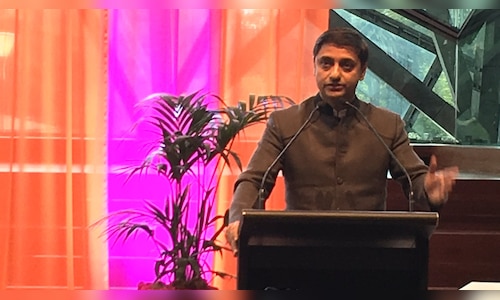
Speaking to CNBC-TV18, Sanyal noted that while high-frequency data suggests some deceleration, the tools to counteract it are well within reach. “We take these signals seriously,” Sanyal said, referring to the slowdown reflected in industrial output, core sectors, and auto sales. “But we have lots of space on both the fiscal and monetary sides to respond.” He highlighted that the Reserve Bank of India (RBI) has yet to embark on a significant easing cycle and that fiscal spending, particularly on capital expenditure, could be ramped up without breaching budgetary limits.
The recent rise in inflation, driven largely by food prices, has sparked debates about the appropriateness of monetary easing. Headline inflation stood at 6.2%, but Sanyal pointed to declining vegetable prices as a potential moderating factor. Ultimately, he left the decision to the RBI’s Monetary Policy Committee (MPC), which he said is well-versed in the trade-offs between inflation control and growth support.
Sanyal also touched upon the global landscape, particularly the potential economic implications of Donald Trump’s presidency in the United States. According to Sanyal, increased tariffs, especially on Chinese goods, could indirectly benefit India by making its exports more competitive. However, he acknowledged that the global trade environment under Trump could increase uncertainty and inflation in the US, with ripple effects globally.
Below are the excerpts of the interview.
Q: How much would you worry about the slowdown signs we saw in the second quarter?
Sanyal: We watch the cyclical indicators, high-frequency indicators, and yes some of those indicators are signalling some degree of slowdown, so we take that seriously. On the other hand, we have lots of space on the fiscal side and on the monetary side to respond. It’s not like we don’t have the tools to respond.
The RBI has not yet even embarked on the easing cycle. Those tools are there. And of course, on the fiscal side, we have been quite tight fiscally. Some would even accuse us that the spending is lagging behind the budget numbers on the capital spending side. That is something we can easily ramp up even while remaining within our budgeted numbers. There’s lots of space on the fiscal and monetary side to respond.
Q: What is hurting is urban consumption. We saw that in most of the FMCG companies, metro consumption has gone down. Will that recover with government spending, or with this better-than-expected monsoon? That seems to be a persisting pain point.
Sanyal: The economy doesn’t function in silos. If you spend on one part of the economy, the cash flow and other parts also improve. We’ll see how it goes. We have to be always careful that when we do some sort of a monetary, fiscal or any other kind of measure, we do it in a measured way, and don’t overdo it as well. And you’ve seen that we are quite conservative, but that doesn’t mean that we don’t pay attention. We have already begun to pay attention to this. And as you mentioned, some responses are already in the pipeline.
Q: The last inflation number we got was 6.2% largely because of food prices. But regardless, the headline inflation is 6.2% so can there be monetary easing in spite of that?
Sanyal: That’s a judgment the Monetary Policy Committee has to take. These are the kinds of trade-offs that policymakers make all the time on a routine basis. These numbers evolve and we have now new data in which the vegetable prices have come off. Have they come off enough? We’ll see. But it’s not that none of these issues are not known to the Reserve Bank or to the Monetary Policy Committee. They are also making trade-offs along the way. It’s a matter of making practical trade-offs. A car is driven both with an accelerator and a brake. And the art of combining the two is really about how you drive it. So, we as policy makers are paying close attention to all these issues.
Q: There is some discussion these days that it is food inflation and it is not core inflation, so interest rate should not be the weapon. Where are you in that discussion?
Sanyal: I understand there’s no rocket science in any which way. All these arguments are routinely made, and every time there is a debate about whether to change the direction of monetary or fiscal policy. All the members of the Monetary Policy Committee are aware of these issues. The Reserve Bank and the governor and his team are also aware of it. We here at the government in the Prime Minister’s Economic Council are aware. The finance ministry is aware. These are all trade-offs we have to make. I can’t speak for the MPC, but some trade-offs will be made. It’s not because of a lack of understanding of these trade-offs.
Q: Let me come to the new development globally, the election of President Trump, and probably along with both houses of Congress. How do you think things change for the global economy? Are you expecting more uncertainty, more inflation? Just what are the first thoughts?
Sanyal: We have worked with President Trump in the past, so he’s not an entirely unknown person, and his ideas are not unknown. We will deal with it as it comes. He has signalled ahead that he intends to increase tariffs specifically on the Chinese but also on everybody else. So there may be some tariff increases for us as well. On the other hand, if there are massive increases on Chinese tariffs, then on a relative basis, we could benefit. There can also be a situation, because if the idea behind all of this is a return of manufacturing to the US, let me point out that they too have to make trade-offs. Let’s say they do attempt, they dramatically increase tariffs on all products, some more for Chinese, but for everybody and attempt to manufacture stuff in the US, fair enough. But then, do remember what happens for them? First of all, inflation will go up in the US, but not in the rest of the world, because, remember, it will have a dampening effect on the rest of the world, but increase inflation in the US. To compensate for that, they will have to outsource non-merchandise activities to the rest of the world. After all, they can’t manufacture everything, especially when they’re pushing out illegal immigrants who could be potentially cheap labour for their factories. So in that situation, they will have to make a trade-off. And that trade-off they will eventually make is that they will have to outsource all their services inputs, which, ironically, is good for us. So I can’t predict exactly how this will work out, but in any system you are making trade-offs. If their trade-off is to hike tariffs, then they’ll have to accept some inflation, and they will have to accept outsourcing of services which is good for us.
Q: But my only worry on this issue is whether there will be global uncertainty, because, again, supply chains are disrupted. Business decisions could get delayed. Do you think that when you estimate FY26 India, GDP, we have to account for a global headwind rather than a tailwind?
Sanyal: We already have a headwind problem, because the world economy has been weak for some time. And so it’s not new. Whether this will add or subtract from it, I can only comment when I know exactly what will happen. And we are used to doing this. I mean, the game is not to have some grand five-year plan. The flexibility of the fiscal and monetary and other policy responses is the game. And I hope we have demonstrated repeatedly that we are quite capable of doing it, whether it was during COVID or subsequently we have shown that the Indian policy makers are among the most responsive and flexible in the world.
Our game is not to predict what will happen, but to move fast as it happens, because there are infinite number of things that can happen, and the world is always uncertain. I’ve never seen the world not being uncertain. So nimbleness is a very important part of the game. Let’s see what happens, and we’ll respond. My point is that no matter what happens, we can tell you that we will get you a good deal given the circumstances. So whether it is being able to manoeuvre enough to get Russian oil during the oil price spike, or any other thing you have seen, we repeatedly move reasonably fast and long, even though we get criticised sometimes in the short run, I think the longer term, people have seen that most of the trade-offs we make are generally good ones.
Q: Let me come to this other interesting idea that Trump has put on the table, and it’s good to go – the Department of Government Efficiency to be run by Vivek Ramaswamy and Elon Musk from outside the government to cut it down probably by $2 trillion. Your comment, I mean, in the first place, won’t that mean a bit of slowdown in the economy?
Sanyal: Let me say that an effort to make a government efficient, particularly the US government, is a very good thing. Any large system accumulates huge amounts of inefficiencies over time. There are departments that may have been useful once upon a time, but have sort of hung around for longer than they should have, regulations, taxes, processes. So that’s true of every government. It’s true of India as well. As you may be aware, we have a big effort to do process reforms right here, and I personally have been part of that effort to do process reforms. Now a few things where we are different in our effort from what at least so far, the Musk-Ramaswamy effort with the DoGE sort of plan.
So the way we have gone about it in India is that the process reform effort has been done by basically crossing the stream by feeling the pebbles. We have not gone in the disruptive way that they are planning it. Now some may say that you are being too gradualist, but let me tell you that their attempt is to cross the stream by doing a pole vault.
Now, sure you may get lucky and be able to do it right across in one shot. Best of luck to them. But I think they will quickly discover the following problem, which is why we have been much more gradualist, which is that you have to essentially fix the machine by still keeping the machine running. You can’t shut down the machine. The government can’t be shut down, and you can’t clean it up and then restart it. So, the efforts I have been making to do these kinds of changes, I have discovered that there are all kinds of unintended consequences. So let’s say there is a department or unit or autonomous body that needs to be shut down. Let’s say that’s true. But there may be 10-20% of the activities of that department that are actually useful, and somebody else should be doing it. If you shut down the entire department, you will actually cause something else to jam up. Now, in order to be able to look at that department, figure out that this is the 20% that is worth saving, that requires effort, then you need to make sure you save that bit and transfer it somewhere else where it continues to happen, or you change the whole process altogether so that things don’t break down even if it is the case that 80% of the activities of that department should be shut down. So that requires a much more nuanced application of mind than you can do with slash and burn kind of thing that is at least at the first instance being promised.
So I personally feel that they will, over time, temper their effort. There will be some obvious things you can shut down right at the beginning, but they will discover that they have to do it slowly.
$2 trillion I’m sure, can be cut from their spending, but I don’t think they will be able to do it in the first year. It will require them at least four years to get there and presumably if they have done it in the correct way. The efficiency gains themselves will generate economic activities that will more than compensate for it. But if they try to do it in one shot in the first year, yes, it will cause all kinds of log jams.
Watch the video for more



